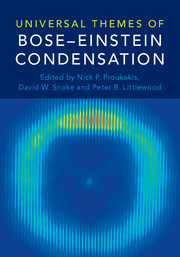Book contents
- Frontmatter
- Contents
- Foreword
- Preface
- Part I Introduction
- Part II General Topics
- Editorial Notes
- 5 The Question of Spontaneous Symmetry Breaking in Condensates
- 6 Effects of Interactions on Bose-Einstein Condensation
- 7 Formation of Bose-Einstein Condensates
- 8 Quenches, Relaxation, and Prethermalization in an Isolated Quantum System
- 9 Ultracold Gases with Intrinsic Scale Invariance
- 10 Berezinskii-Kosterlitz-Thouless Phase of a Driven-Dissipative Condensate
- 11 Superfluidity and Phase Correlations of Driven Dissipative Condensates
- 12 BEC to BCS Crossover from Superconductors to Polaritons
- Part III Condensates in Atomic Physics
- Part IV Condensates in Condensed Matter Physics
- Part V Condensates in Astrophysics and Cosmology
- Universal Bose-Einstein Condensation Workshop
- Contributors
- Index
- References
9 - Ultracold Gases with Intrinsic Scale Invariance
from Part II - General Topics
Published online by Cambridge University Press: 18 May 2017
- Frontmatter
- Contents
- Foreword
- Preface
- Part I Introduction
- Part II General Topics
- Editorial Notes
- 5 The Question of Spontaneous Symmetry Breaking in Condensates
- 6 Effects of Interactions on Bose-Einstein Condensation
- 7 Formation of Bose-Einstein Condensates
- 8 Quenches, Relaxation, and Prethermalization in an Isolated Quantum System
- 9 Ultracold Gases with Intrinsic Scale Invariance
- 10 Berezinskii-Kosterlitz-Thouless Phase of a Driven-Dissipative Condensate
- 11 Superfluidity and Phase Correlations of Driven Dissipative Condensates
- 12 BEC to BCS Crossover from Superconductors to Polaritons
- Part III Condensates in Atomic Physics
- Part IV Condensates in Condensed Matter Physics
- Part V Condensates in Astrophysics and Cosmology
- Universal Bose-Einstein Condensation Workshop
- Contributors
- Index
- References
Summary
Scale invariance is conventionally discussed in the context of critical phenomena near a continuous phase transition. In atomic gases, a new class of scale invariant systems emerges, which we call “intrinsic scale invariance.” In these systems, the scaling symmetry does not rely on a phase transition, but comes from the balance of kinetic and interaction energy at different length scales. Three examples are discussed here: three-dimensional unitary Fermi gas, two-dimensional dilute Bose gas, and unitary Bose gas. The first two are invariant under continuous scaling transformation, and thus they share the same universal thermodynamics. Unitary Bose gas is a special case with expected discrete scaling symmetry because of Efimov three-body physics.We show that the discrete scale invariance can be captured by a complex scaling dimension and suggest a universal form for the observables.
Introduction
The achievement of atomic Bose-Einstein condensation (BEC) in 1995 initiated a new adventure to explore quantum many-body phenomena in the gas phase, a journey that has yielded much excitement and is still progressing fast. Because of their diluteness, ultracold atomic gases can be precisely modeled and characterized with high accuracy. In addition, new opportunities have emerged in the past decade to prepare cold atoms in the strong coupling regime. By loading the samples into optical lattices [1] or tuning them near a Feshbach resonance [2], for instance, cold atoms offer a unique platform to investigate strongly correlated quantum phenomena. Examples include the superfluid-Mott insulator transition [3] (see also Chapter 13), BEC-BCS (Bardeen-Cooper-Schrieffer) crossover [4, 5, 6, 7] (see also related overview in Chapter 12), Efimov trimer states [8], and Berezinskii- Kosterlitz-Thouless transition in two dimensions [9] (see also Chapter 10). One key motivation in these explorations is to uncover new, universal laws that underpin the behavior of strong-coupled few- and many-body quantum systems.
In this chapter, we discuss “scale invariance” as a generic attribute in various cold atom systems, including all of the aforementioned examples. While scale invariance is conventionally discussed in the context of critical phenomena, the cold atom systems that interest us belong to a new class, which we call “intrinsic scale invariance.”
In the following, we first overview the main features of different types of scale invariance and discuss related examples in cold atom systems.
- Type
- Chapter
- Information
- Universal Themes of Bose-Einstein Condensation , pp. 168 - 186Publisher: Cambridge University PressPrint publication year: 2017

